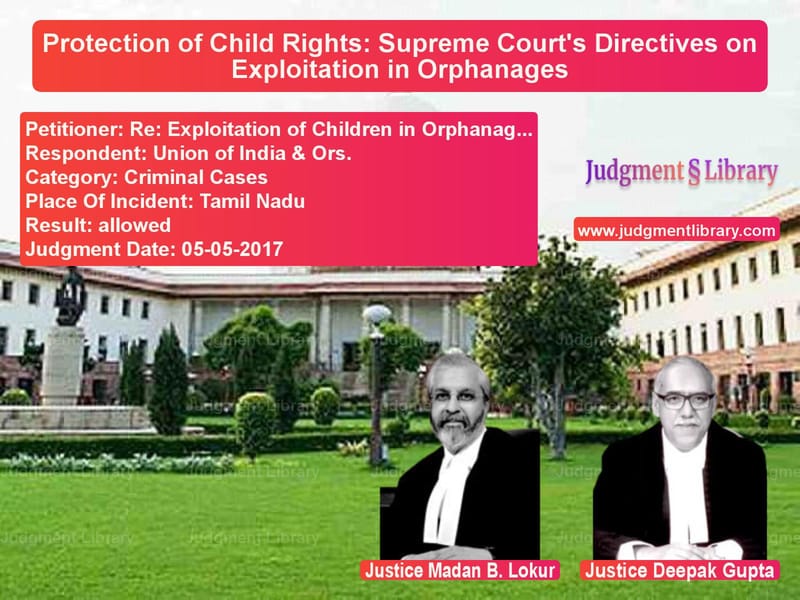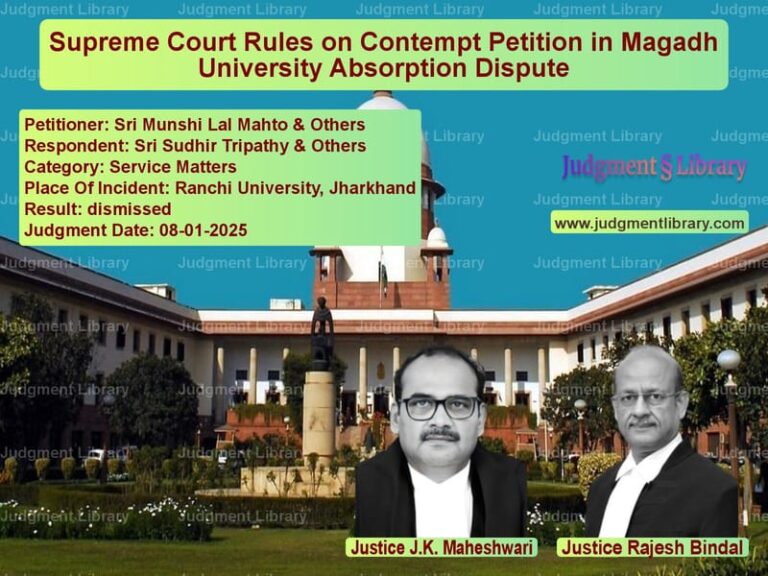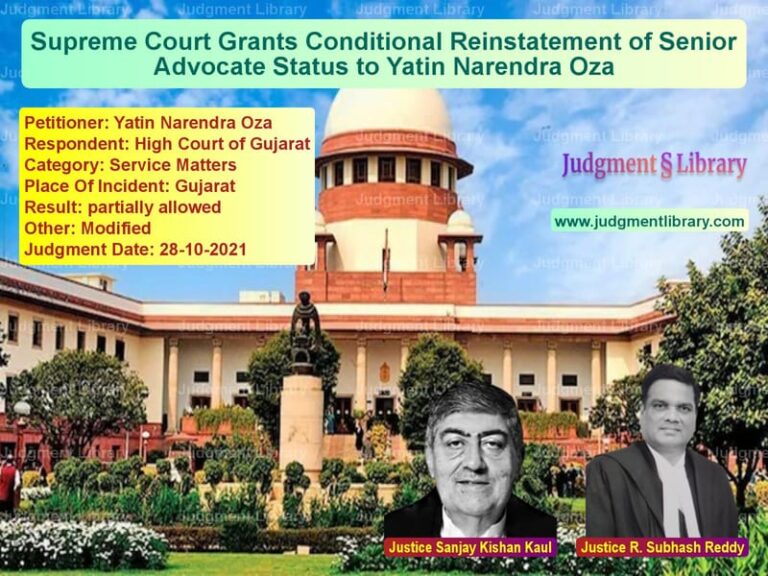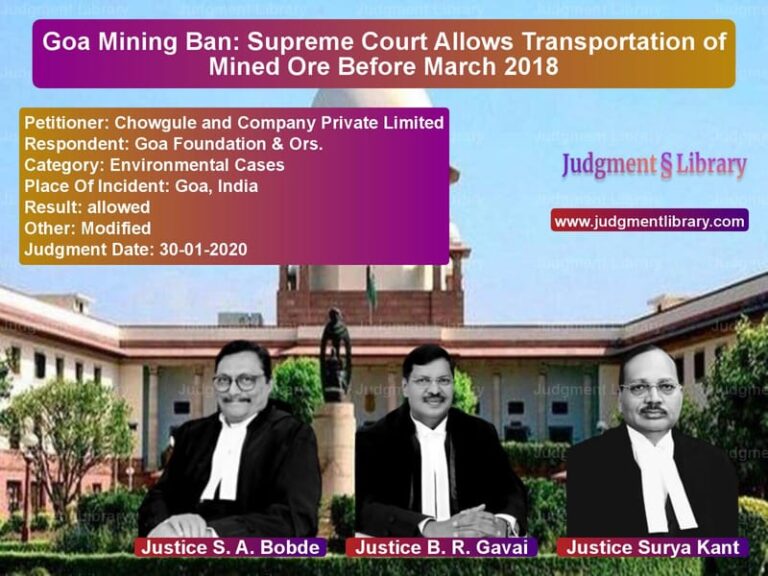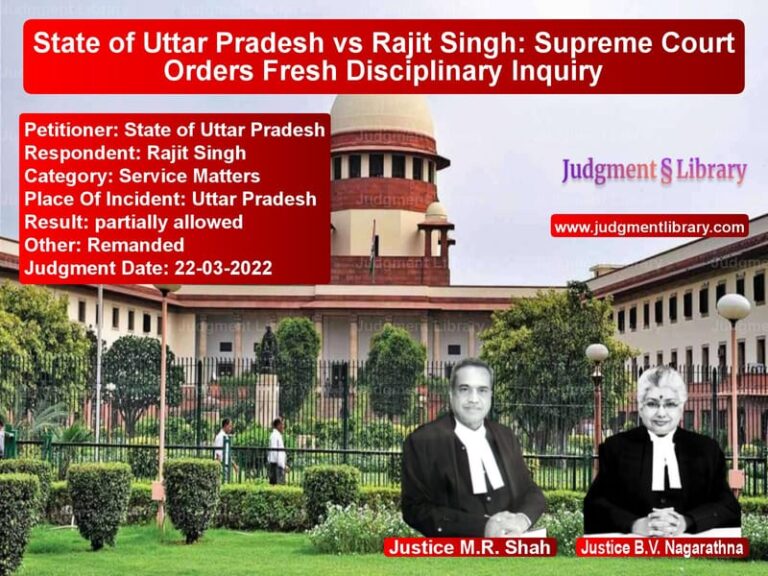Protection of Child Rights: Supreme Court’s Directives on Exploitation in Orphanages
The case of Re: Exploitation of Children in Orphanages in Tamil Nadu vs. Union of India & Ors. is a landmark judgment concerning the protection of child rights in India. The Supreme Court took cognizance of the case as a Public Interest Litigation (PIL) following a news article titled “Orphanage or Places for Child Abuse”, published in the Hindi newspaper “Hindustan” (Lucknow Edition) on July 4, 2007. The article exposed widespread child abuse in orphanages in Tamil Nadu, prompting judicial intervention.
Background of the Case
The case originated from a letter sent to the Supreme Court by an individual named A.S. Choudhury, forwarding the article written by journalist Anjali Sinha. The article alleged that orphanages, both government-run and managed by NGOs in Tamil Nadu, were involved in systemic child abuse, including instances where children were sexually exploited by foreign and domestic tourists. It highlighted a shocking reality that demanded urgent legal and policy-based solutions.
The Court appointed Ms. Aparna Bhat as Amicus Curiae to assist in the matter. Over a decade, multiple hearings took place, expanding the scope of the PIL to include broader issues such as child trafficking, juvenile justice, the right to education, and the implementation of child protection laws.
Key Legal Provisions Discussed
1. Protection of Children from Sexual Offences (POCSO) Act, 2012
The Court examined how the POCSO Act addresses child sexual abuse and whether its implementation was effective in preventing exploitation in orphanages.
2. Juvenile Justice (Care and Protection of Children) Act, 2015
The Juvenile Justice Act lays down procedures for handling children in need of care and protection. The Court emphasized the necessity of robust enforcement mechanisms.
3. The Right of Children to Free and Compulsory Education Act, 2009
The Court addressed the importance of education in protecting children from exploitation and ensuring their rehabilitation.
4. The Commissions for Protection of Child Rights Act, 2005
The Court noted that while child protection commissions existed, many were dysfunctional due to vacancies and lack of resources.
Arguments Presented
Petitioner’s (Public Interest Litigants and Amicus Curiae) Arguments
- The government had failed in its constitutional obligation to protect children in orphanages from abuse and exploitation.
- Many orphanages were unregistered, making it difficult to regulate them.
- The lack of trained personnel in child protection mechanisms contributed to the problem.
- There was an urgent need for social audits of child care institutions.
Respondent’s (Union of India & State Governments) Arguments
- The government claimed that steps were being taken to improve child protection laws.
- Efforts were being made to ensure compliance with the Juvenile Justice Act and POCSO Act.
- The Ministry of Women and Child Development had initiated various schemes for child welfare.
Supreme Court’s Key Observations
The Supreme Court, in its detailed judgment, made several critical observations:
- Despite numerous directives, state governments had not taken adequate measures to ensure child protection.
- Many child care institutions were operating without registration, making it difficult to regulate their activities.
- The lack of social audits had led to a lack of transparency and accountability in the functioning of orphanages.
- The protection of child rights required collaboration between the judiciary, government agencies, civil society, and law enforcement.
Final Judgment and Directives
The Supreme Court issued the following major directives:
- Mandatory Registration: All child care institutions must be registered under the Juvenile Justice Act.
- Implementation of Minimum Standards: The government must ensure proper facilities in orphanages, including healthcare, education, and rehabilitation.
- Social Audits: The National Commission for Protection of Child Rights (NCPCR) must conduct periodic social audits.
- Staff Training: States must train personnel handling child welfare cases to ensure they understand child protection laws.
- Establishment of Juvenile Justice Committees: High Courts must oversee the implementation of child protection measures.
Significance of the Judgment
This judgment is significant for several reasons:
- It ensures stricter monitoring of orphanages and child care institutions.
- It highlights the importance of enforcing child protection laws in letter and spirit.
- It emphasizes the role of social audits in preventing abuse.
- It establishes a framework for collaboration between government and civil society.
Conclusion
The Supreme Court’s ruling in Re: Exploitation of Children in Orphanages in Tamil Nadu sets a crucial precedent for child rights protection in India. By mandating stricter regulations and social audits, the judgment seeks to ensure that no child suffers exploitation under institutional care. This case reaffirms that protecting children is not just a legal obligation but a moral and social imperative.
Don’t miss out on the full details! Download the complete judgment in PDF format below and gain valuable insights instantly!
Download Judgment: Re Exploitation of vs Union of India & Ors Supreme Court of India Judgment Dated 05-05-2017.pdf
Direct Downlaod Judgment: Direct downlaod this Judgment
See all petitions in Juvenile Justice
See all petitions in Judgment by Madan B. Lokur
See all petitions in Judgment by Deepak Gupta
See all petitions in allowed
See all petitions in supreme court of India judgments May 2017
See all petitions in 2017 judgments
See all posts in Criminal Cases Category
See all allowed petitions in Criminal Cases Category
See all Dismissed petitions in Criminal Cases Category
See all partially allowed petitions in Criminal Cases Category

